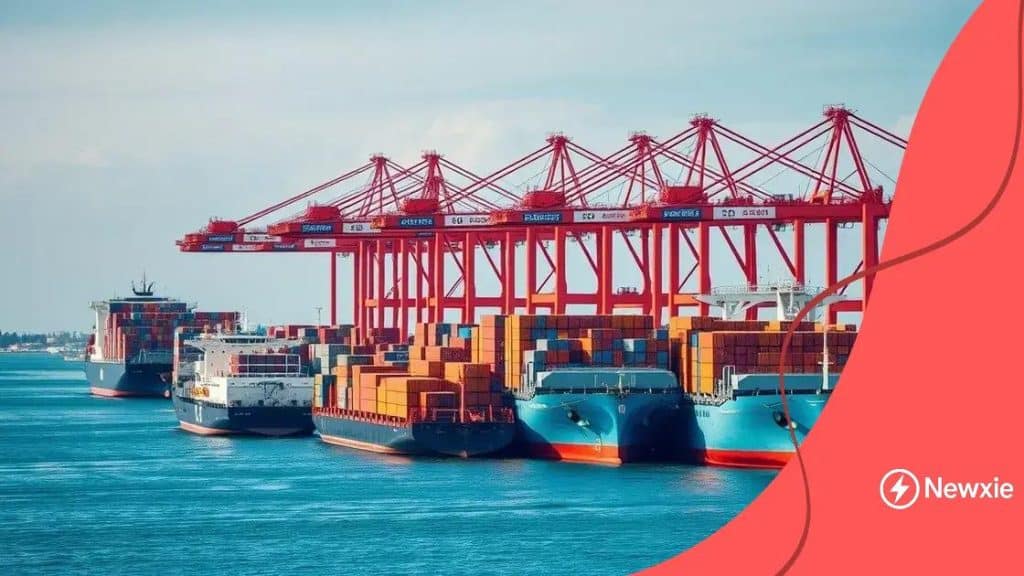Efforts to stabilize and rebuild global supply chains

Anúncios
Efforts to stabilize and rebuild global supply chains focus on adopting technology, enhancing sustainability, and fostering strong partnerships to ensure efficiency and resilience against future disruptions.
Efforts to stabilize and rebuild global supply chains have become a pressing issue as businesses face unprecedented disruptions. Have you wondered how these changes impact everyday goods and services? This article dives into the heart of supply chain recovery, exploring challenges and innovative strategies that can pave the way for a resilient future.
Understanding the current state of global supply chains
Anúncios
Understanding the current state of global supply chains is essential for businesses navigating today’s complex market. Many companies face disruptions that affect their ability to deliver goods efficiently. By examining the key factors at play, you can better grasp how to manage these challenges effectively.
Current Challenges That Impact Supply Chains
Today, various obstacles hinder the smooth operation of global supply chains. These include:
- Pandemic-related delays and shutdowns
- Increased shipping costs and shortages
- Fluctuating demand due to market conditions
- Natural disasters affecting logistics
Each of these factors creates a ripple effect that can disrupt operations. Companies are now recognizing the need for flexibility and adaptability in their supply chain strategies.
Trends Influencing Supply Chain Landscape
As we look ahead, certain trends are shaping the future of global supply chains. Companies are becoming more reliant on technology and data analytics to predict potential disruptions. Furthermore, sustainability is gaining importance, prompting businesses to consider how their supply chains impact the environment. Another vital trend is the diversification of suppliers, which can minimize risks.
Anúncios
Investing in technology not only improves efficiency but also allows for real-time tracking of inventory. The integration of artificial intelligence is also providing companies with better forecasting capabilities, leading to smarter decision-making.
In conclusion, understanding the current state of global supply chains requires awareness of numerous challenges and emerging trends. By adapting to these changes, businesses can enhance their resilience and maintain their competitive edge in the marketplace.
Key challenges in stabilizing supply chains
Key challenges in stabilizing supply chains can significantly impact companies worldwide. Businesses are striving to maintain flow and efficiency, but multiple factors complicate this endeavor. Understanding these challenges is vital for developing effective strategies.
Disruptions from Global Events
Recent global events, such as pandemics and geopolitical tensions, have created unexpected hurdles for supply chains. Natural disasters, trade disputes, and even health crises have led to delays and shortages.
- Pandemic-related restrictions causing factory shutdowns
- Increased shipping costs and backlog at ports
- Labor shortages affecting production capacity
These disruptions lead to chain reactions that can take weeks or months to resolve. As companies attempt to adapt, they face mounting pressure on their resources.
Logistical Challenges
Logistics play an essential role in the efficiency of supply chains. Poor planning, insufficient infrastructure, and limited transportation options can create bottlenecks. With rising demand, these logistical issues often become more pronounced.
When logistics falter, even the best forecasting cannot save a company from delays. This situation highlights the need for resilient planning and strategic partnerships to ensure smooth operations.
Additionally, suppliers may struggle to meet the varying demands for different goods. Often, they have to balance multiple clients’ needs simultaneously. The complexity of managing these relationships adds another layer of challenge.
As businesses work to stabilize their supply chains, focusing on flexibility and responsiveness becomes crucial. By preparing for uncertainty, companies can better position themselves in an evolving marketplace.
Strategies for rebuilding resilient supply chains

Strategies for rebuilding resilient supply chains are crucial for companies facing current challenges. Businesses need to adapt quickly to ensure their operations stay efficient and effective. By focusing on the right approaches, they can strengthen their supply chains against future disruptions.
Embracing Technology
Technology plays a vital role in modernizing and enhancing supply chains. By implementing advanced technologies like artificial intelligence and machine learning, companies can analyze data and make informed decisions faster. This capability allows businesses to anticipate potential issues and react accordingly.
- Utilizing real-time tracking systems for inventory
- Implementing predictive analytics to gauge demand
- Automating processes to reduce human error
As organizations enhance their technology, they can significantly increase their responsiveness and efficiency.
Building Strong Partnerships
Moreover, creating strong partnerships with suppliers is essential for a resilient supply chain. When companies collaborate closely with their suppliers, it fosters better communication and trust. This relationship enables smoother operations and can lead to cost savings.
Such partnerships often result in shared information that benefits both parties. Establishing clear agreements regarding expectations and performance can also minimize disruptions. Companies that build solid relationships will find themselves better prepared for challenges.
Investing in supplier diversification is another effective strategy. By engaging multiple suppliers, businesses can reduce their dependency on a single source, making them less vulnerable to supply chain shocks. This approach ensures a steady flow of materials and resources.
The role of technology in supply chain recovery
The role of technology in supply chain recovery is becoming increasingly vital. Businesses are relying on innovative solutions to bounce back from disruptions. By adopting the right technologies, companies can enhance efficiency and adapt quickly to changing circumstances.
Automation and Robotics
Automation plays a crucial role in streamlining operations. Using robots in warehouses can improve productivity, reduce costs, and minimize errors. Automated systems can swiftly manage inventory and fulfill orders faster than traditional methods.
- Streamlined warehouse management
- Faster order processing times
- Reduced labor costs
Additionally, automation empowers employees to focus on more strategic tasks rather than mundane activities. This shift brings about a more productive work environment.
Data Analytics for Insights
Data analytics is another key technology that helps organizations make informed decisions. By analyzing data, companies can anticipate demand fluctuations and respond accordingly. This capability is vital during recovery as it enables businesses to adjust their operations based on real-time insights.
With advanced analytics, companies can track supply chain performance, identify bottlenecks, and highlight areas for improvement. These insights support proactive decision-making, allowing businesses to navigate challenges more effectively.
Furthermore, integrating advanced technologies helps build transparency in supply chains. As a result, stakeholders can share valuable information, leading to improved collaboration and efficiency across the board.
Future trends in global supply chain management
Future trends in global supply chain management are shaping the way businesses operate. As companies adapt to changing environments, several key trends are emerging that will influence how they manage their supply chains.
Sustainability Initiatives
Sustainability is becoming a priority for many organizations. Companies are increasingly focusing on reducing their environmental impact by implementing sustainable practices. This shift involves sourcing materials responsibly and minimizing waste in operations.
- Investing in eco-friendly packaging
- Utilizing renewable energy sources
- Optimizing transportation routes to reduce carbon footprints
These initiatives not only help the planet but also attract environmentally conscious consumers.
Digital Transformation
Digital transformation is another pivotal trend. Organizations are embracing technologies like blockchain and IoT (Internet of Things) to increase transparency and traceability in their supply chains. These technologies enable better tracking of products from suppliers to consumers, ensuring accountability.
With real-time data, businesses can make quicker, more informed decisions. This connectivity streamlines operations and enhances overall efficiency. The adoption of cloud technologies allows companies to scale their operations and manage resources more effectively.
As digital tools evolve, companies that leverage them will find themselves ahead of the competition. The focus will be on integrating advanced analytics to forecast demand accurately. By understanding customer preferences, companies can tailor their offerings to meet market needs.
FAQ – Frequently Asked Questions about Global Supply Chain Management
What are the key challenges in global supply chain management?
Key challenges include disruptions from global events, logistical issues, and fluctuations in demand that can impact efficiency.
How can technology improve supply chain recovery?
Technology, especially automation and data analytics, can streamline operations, enhance transparency, and enable real-time tracking.
Why is sustainability important in supply chains?
Sustainability helps reduce environmental impact, meets consumer demand for eco-friendly practices, and can improve brand reputation.
What strategies can companies adopt for a resilient supply chain?
Companies can embrace technology, build strong supplier partnerships, and implement sustainable practices to enhance resilience.
SEE MORE CONTENT





